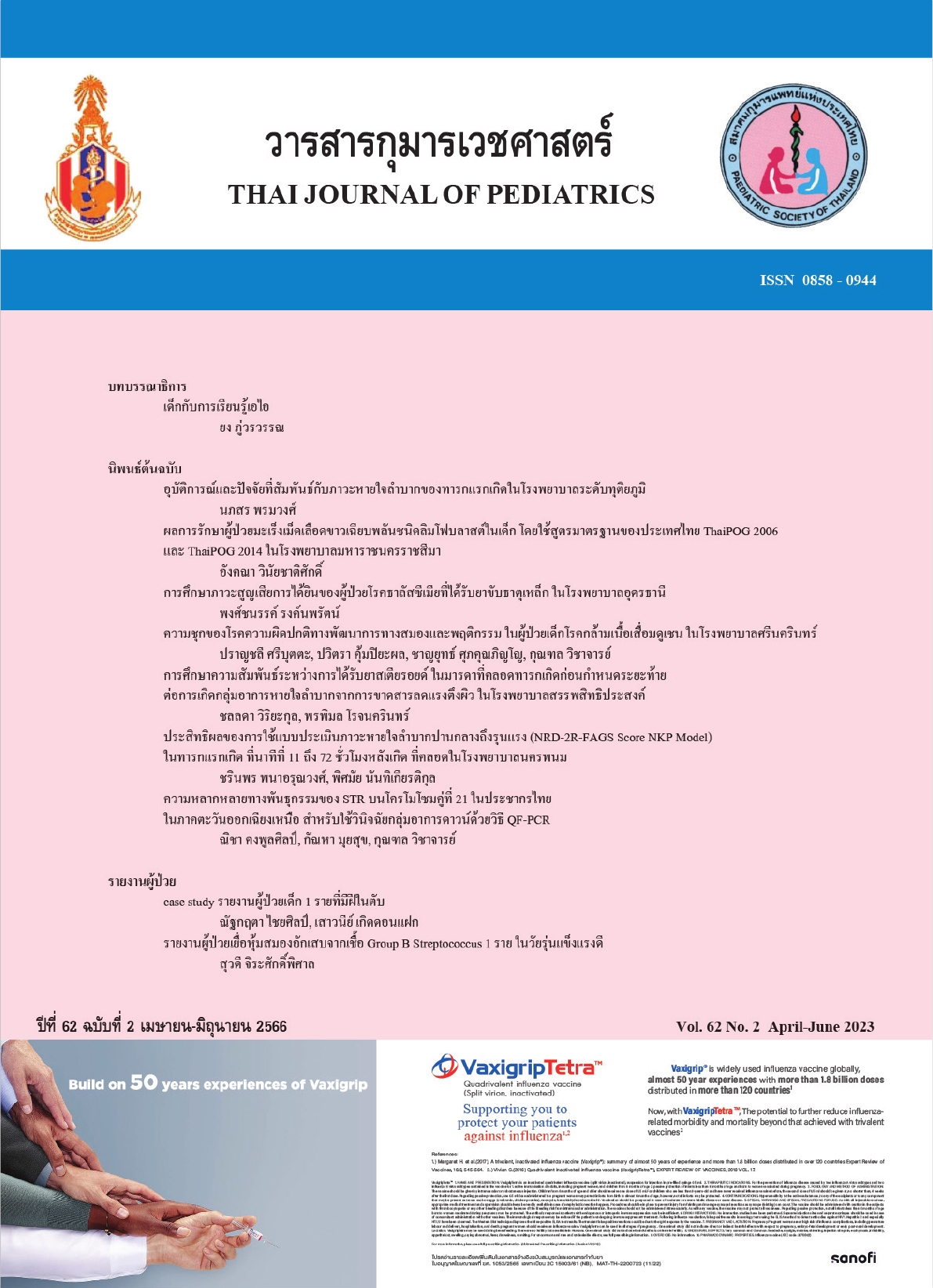การให้ยาเสริมธาตุเหล็กในเด็กอายุ 4 เดือน เพื่อป้องกันการเกิดภาวะโลหิตจาง จากการขาดธาตุเหล็กในเด็กเล็ก
คำสำคัญ:
Iron deficiency anemia, Iron supplement, Hemoglobin, Serum ferritinบทคัดย่อ
วัตถุุประสงค์: การศึกษาผลการเสริมยาธาตุเหล็กต่อระดับฮีโมโกลบินและระดับธาตุเหล็กในเลือด ในเด็กอายุ 9 เดือน
วิธีการ: ในการทดลองควบคุมแบบสุ่มนี้ มีกลุ่มศึกษา (n=20) และกลุ่มควบคุม (n=20) เด็กอายุ 4 เดือน ในกลุ่มศึกษาจะได้รับยาเสริมธาตุเหล็ก (1.5-2 มิลลิกรัมต่อกิโลกรัมต่อวัน) และกลุ่มควบคุมจะได้รับยาหลอกในปริมาณที่เท่ากัน เมื่อวัดระดับฮีโมโกลบินและระดับธาตุเหล็กในเลือดที่อายุ 4 และ 9 เดือน (หลังรับประทานยา 5 เดือน) โดยผลการศึกษาหลักเพื่อเปรียบเทียบระดับฮีโมโกลบินและระดับธาตุเหล็ก ในเลือดระหว่างกลุ่มศึกษาและกลุ่มควบคุม และผลการศึกษารองเพื่อศึกษาความชุกของการเกิดภาวะ ขาดธาตุเหล็กและภาวะโลหิตจางจากการขาดธาตุเหล็กที่อายุ 9 เดือน
ผลการศึกษา: ผลของการให้ยาเสริมธาตุเหล็กสามารถเพิ่มน้ำหนัก, เพิ่มระดับธาตุเหล็กในเลือด, เพิ่มระดับฮีโมโกลบินในเลือด, และการเปลี่ยนแปลงของระดับฮีโมโกลบิน และระดับธาตุเหล็กในช่วง 5 เดือน ในกลุ่มศึกษามีแนวโน้มเพิ่มขึ้น เมื่อเปรียบเทียบกับกลุ่มควบคุม และยังลดความชุกของการเกิดภาวะโลหิตจางจากการขาดธาตุเหล็กในเด็กอายุ 9 เดือนได้
สรุป: การให้ยาเสริมธาตุเหล็กเป็นเวลา 5 เดือน สามารถช่วยลดการเกิดภาวะโลหิตจางจากการขาดธาตุเหล็กในเด็กอายุ 4-9 เดือนได้ และการให้ยาเสริมธาตุเหล็กยังสามารถเพิ่มระดับฮีโมโกลบินและระดับธาตุเหล็กในเลือดได้
Downloads
เอกสารอ้างอิง
Moscheo C, Licciardello M, Samperi P, La Spina M, Di Cataldo A, Russo G. New Insights into Iron Deficiency Anemia in Children: A Practical Review. Metabolites. 2022;12:289.
World Health Organization. The World Health Report 2002: Reducing risks, promoting healthy life. Geneva, World Health Organization, 2002
Rojroongwasinkul N, Kijboonchoo K, Wimonpeerapattana W, et al. SEANUTS: the nutritional status and dietary intakes of 0.5-12-year-old Thai children. Br J Nutr. 2013;110 S36-44.
Buchanan GR. Paucity of clinical trials in iron deficiency: lessons learned from study of VLBW infants. Pediatrics, 2031; 13: e582-4.
Baker RD, Greer FR; Committee on Nutrition American Academy of Pediatrics. Diagnosis and prevention of iron deficiency and iron-deficiency anemia in infants and young children (0-3 years of age). Pediatrics. 2010 Nov;126(5):1040-50.
World Health Organization. Iron deficiency anaemia: assessment, prevention, and control. A guide for programme managers. Geneva, Switzerland: World Health Organization; 2001. WHO/NHD/01.3.
Mast AE, Blinder MA, Gronowski AM, Chumley C, Scott MG, Clinical utility of the soluble transferrin receptor and comparison with serum ferritin in several populations. Clin Chem. 1998;44:45–51.
Domellöf M, Cohen RJ, Dewey KG, Hernell O, Rivera LL, Lönnerdal B. Iron supplementation of breast-fed Honduran and Swedish infants from 4 to 9 months of age. J Pediatr. 2001;138:679-87.
Pasricha SR, Hayes E, Kalumba K, Biggs BA. Effect of daily iron supplementation on health in children aged 4-23 months: a systematic review and meta-analysis of randomised controlled trials. Lancet Glob Health. 2013;1:e77-e86. Erratum in: Lancet Glob Health. 2014 Mar 2(3):e144.
Jain S, Chopra H, Garg SK, Bhatnagar M, Singh JV. Anemia in children: early iron supplementation. Indian J Pediatr. 2000.
Petry N. Olofin I, Boy E, Donahue Angel M, Rohner F. The effect of low dose Iron and Zinc Intake on Child Micronutrient Status and Development during the First 1000 days of Life: A Systematic Review and MetaAnalysis. Nutrients 2016;8:773.
Dewey KG, Domellöf M, Cohen RJ, Landa Rivera L, Hernell O, Lönnerdal B, Iron supplementation affects growth and morbidity of breast-fed infants: results of a randomized trial in Sweden and Honduras, J Nutr. 2002;132:3249-55.
Cai C, Granger M, Eck P, Friel J. Effect of Daily Iron Supplementation in Healthy Exclusively Breastfed Infants: A Systematic Review with Meta-Analysis. Breastfeed Med. 2017;12:597-603.
ดาวน์โหลด
เผยแพร่แล้ว
รูปแบบการอ้างอิง
ฉบับ
ประเภทบทความ
สัญญาอนุญาต

อนุญาตภายใต้เงื่อนไข Creative Commons Attribution-NonCommercial-NoDerivatives 4.0 International License.



